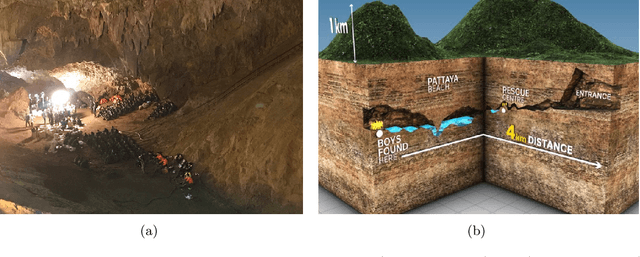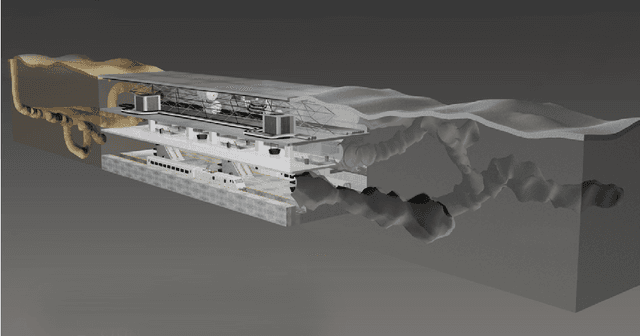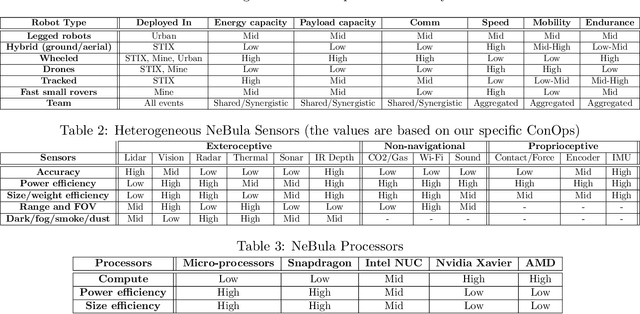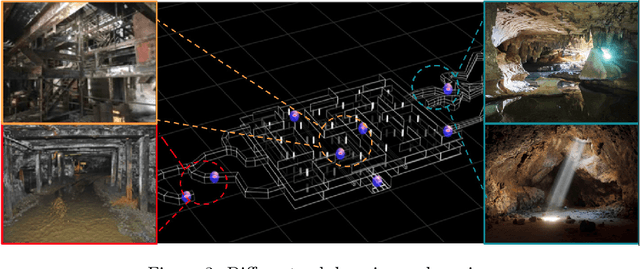Gustavo Correa
NeBula: Quest for Robotic Autonomy in Challenging Environments; TEAM CoSTAR at the DARPA Subterranean Challenge
Mar 28, 2021



Abstract:This paper presents and discusses algorithms, hardware, and software architecture developed by the TEAM CoSTAR (Collaborative SubTerranean Autonomous Robots), competing in the DARPA Subterranean Challenge. Specifically, it presents the techniques utilized within the Tunnel (2019) and Urban (2020) competitions, where CoSTAR achieved 2nd and 1st place, respectively. We also discuss CoSTAR's demonstrations in Martian-analog surface and subsurface (lava tubes) exploration. The paper introduces our autonomy solution, referred to as NeBula (Networked Belief-aware Perceptual Autonomy). NeBula is an uncertainty-aware framework that aims at enabling resilient and modular autonomy solutions by performing reasoning and decision making in the belief space (space of probability distributions over the robot and world states). We discuss various components of the NeBula framework, including: (i) geometric and semantic environment mapping; (ii) a multi-modal positioning system; (iii) traversability analysis and local planning; (iv) global motion planning and exploration behavior; (i) risk-aware mission planning; (vi) networking and decentralized reasoning; and (vii) learning-enabled adaptation. We discuss the performance of NeBula on several robot types (e.g. wheeled, legged, flying), in various environments. We discuss the specific results and lessons learned from fielding this solution in the challenging courses of the DARPA Subterranean Challenge competition.
OpenRoACH: A Durable Open-Source Hexapedal Platform with Onboard Robot Operating System (ROS)
Mar 01, 2019



Abstract:OpenRoACH is a 15-cm 200-gram self-contained hexapedal robot with an onboard single-board computer. To our knowledge, it is the smallest legged robot with the capability of running the Robot Operating System (ROS) onboard. The robot is fully open sourced, uses accessible materials and off-the-shelf electronic components, can be fabricated with benchtop fast-prototyping machines such as a laser cutter and a 3D printer, and can be assembled by one person within two hours. Its sensory capacity has been tested with gyroscopes, accelerometers, Beacon sensors, color vision sensors, linescan sensors and cameras. It is low-cost within \$150 including structure materials, motors, electronics, and a battery. The capabilities of OpenRoACH are demonstrated with multi-surface walking and running, 24-hour continuous walking burn-ins, carrying 200-gram dynamic payloads and 800-gram static payloads, and ROS control of steering based on camera feedback. Information and files related to mechanical design, fabrication, assembly, electronics, and control algorithms are all publicly available on https://wiki.eecs.berkeley.edu/biomimetics/Main/OpenRoACH.
 Add to Chrome
Add to Chrome Add to Firefox
Add to Firefox Add to Edge
Add to Edge